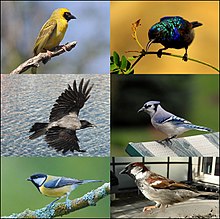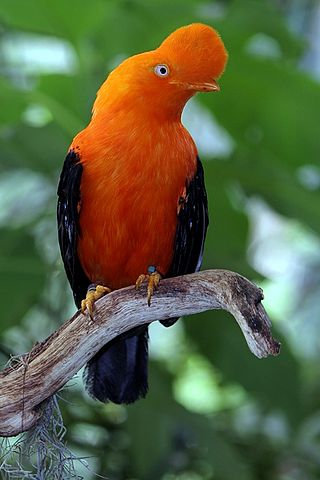Loading AI tools
จากวิกิพีเดีย สารานุกรมเสรี
นกเกาะคอน หรือ นกจับคอน เป็นอันดับของนกอันดับหนึ่ง ในกลุ่มนกขากรรไกรแบบใหม่ ใช้ชื่อวิทยาศาสตร์ว่า Passeriformes (โดยมีที่มาจาก Passer domesticus ซึ่งเป็นชื่อวิทยาศาสตร์ของนกกระจอกใหญ่ และนกในสกุล Passer ที่เป็นนกขนาดเล็กที่ใกล้เคียงกัน)
| นกเกาะคอน ช่วงเวลาที่มีชีวิตอยู่: สมัยอีโอซีน-ปัจจุบัน, 52.5–0Ma | |
|---|---|
 | |
| ตามเข็มนาฬิกาจากบนขวา: Palestine sunbird (Cinnyris osea), blue jay (Cyanocitta cristata), นกกระจอกใหญ่ (Passer domesticus), great tit (Parus major), hooded crow (Corvus cornix), southern masked weaver (Ploceus velatus) | |
| Song of a purple-crowned fairywren (Malurus coronatus) | |
| การจำแนกชั้นทางวิทยาศาสตร์ | |
| โดเมน: | ยูแคริโอตา Eukaryota |
| อาณาจักร: | สัตว์ Animalia |
| ไฟลัม: | สัตว์มีแกนสันหลัง Chordata |
| ชั้น: | สัตว์ปีก |
| เคลด: | Psittacopasserae |
| อันดับ: | นกเกาะคอน Linnaeus, 1758 |
| อันดับย่อย | |
และดูเพิ่มในเนื้อหา | |
| ความหลากหลาย | |
| ราว 140 วงศ์ มากกว่า 6,500 ชนิด[1] | |
นกในอันดับนี้มีลักษณะทั่วไปทางกายภาค คือ เป็นนกที่มีวิวัฒนาการเพื่ออาศัยและหากินบนต้นไม้เป็นหลัก นิ้วตีนมีทั้งหมด 4 นิ้ว ทุกนิ้วเจริญดีและอยู่ในระนาบเดียวกัน จึงเหมาะแก่การจับหรือเกาะเกี่ยวกับกิ่งไม้หรือต้นไม้ในป่าประเภทต่าง ๆ แต่ไม่เหมาะสำหรับการเดินบนพื้นดิน ดังนั้นเมื่อเมื่อลงดินจะได้วิธีก้าวกระโดด โดยมากแล้วจะเป็นนกที่มีลำตัวขนาดเล็ก[2]
ปัจจุบัน นักปักษีวิทยาได้แบ่งอันดับนี้เป็นอันดับย่อย 3 อันดับ โดยพิจารณาจากกล้ามเนื้อควบคุมกล่องเสียงที่อยู่ในลำคอ โดยบางอันดับย่อยจะมีกล้ามเนื้อนี้เพียง 2 คู่ ซึ่งยังเป็นลักษณะของนกในยุคก่อนประวัติศาสตร์ ทำให้เสียงร้องไม่ไพเราะนัก แต่บางอันดับย่อยมีมากกว่า คือมี 4 คู่ ทำให้มีเสียงร้องที่ไพเราะกว่า[3]
นกในอันดับนี้มีมากกว่า 140 วงศ์ ประมาณ 6,500 ชนิด ทั่วโลก[1] สำหรับในประเทศไทยที่มีการค้นพบนกแล้วราว 1,000 ชนิด แบ่งเป็นนกในอันดับต่าง ๆ 16 อันดับ ใน 70 วงศ์ นกที่อยู่ในอันดับนี้นับว่ามากกว่าครึ่ง ได้แก่[4]







| Passeriformes classification | |||||||||||||||||||||||||||||||||||||||||||||||||||||||||||||||||||||||||||||||||||||||||||||||||||||||||||||||||||||||||||||||||||||||||||||||||||||||||||||||||||||||||||||||||||||||||||||||||||||||||||||||||||||||||||||||||||||||||||||||||||||||||||||||||||||||||||||||||||||||||||||||||||||||||||||||||||||||||||||||||||||||||||||||||||||||||||||||||||||||||||||||||||||||||||||||||||||||||||||||||||||||||||||||||||||||||||||||||||||||||||||||||||||||||||||||||||||||||||||||||||||||||||||||||||||||||||||||||||||||||||||||||||||||||||||||||||||||||||||||||||||||||||||||||||||||||||||||||||||||||||||||||||||||||||||||||||||||||||||||||||||||||||||||||||||||||||||||||||||||||||||||||||||||||||||||||||||||||||||||||||||||||||||||||||||||||||||||||||||||||||||||||||||||||||||||||||||||||||||||||||||||
|---|---|---|---|---|---|---|---|---|---|---|---|---|---|---|---|---|---|---|---|---|---|---|---|---|---|---|---|---|---|---|---|---|---|---|---|---|---|---|---|---|---|---|---|---|---|---|---|---|---|---|---|---|---|---|---|---|---|---|---|---|---|---|---|---|---|---|---|---|---|---|---|---|---|---|---|---|---|---|---|---|---|---|---|---|---|---|---|---|---|---|---|---|---|---|---|---|---|---|---|---|---|---|---|---|---|---|---|---|---|---|---|---|---|---|---|---|---|---|---|---|---|---|---|---|---|---|---|---|---|---|---|---|---|---|---|---|---|---|---|---|---|---|---|---|---|---|---|---|---|---|---|---|---|---|---|---|---|---|---|---|---|---|---|---|---|---|---|---|---|---|---|---|---|---|---|---|---|---|---|---|---|---|---|---|---|---|---|---|---|---|---|---|---|---|---|---|---|---|---|---|---|---|---|---|---|---|---|---|---|---|---|---|---|---|---|---|---|---|---|---|---|---|---|---|---|---|---|---|---|---|---|---|---|---|---|---|---|---|---|---|---|---|---|---|---|---|---|---|---|---|---|---|---|---|---|---|---|---|---|---|---|---|---|---|---|---|---|---|---|---|---|---|---|---|---|---|---|---|---|---|---|---|---|---|---|---|---|---|---|---|---|---|---|---|---|---|---|---|---|---|---|---|---|---|---|---|---|---|---|---|---|---|---|---|---|---|---|---|---|---|---|---|---|---|---|---|---|---|---|---|---|---|---|---|---|---|---|---|---|---|---|---|---|---|---|---|---|---|---|---|---|---|---|---|---|---|---|---|---|---|---|---|---|---|---|---|---|---|---|---|---|---|---|---|---|---|---|---|---|---|---|---|---|---|---|---|---|---|---|---|---|---|---|---|---|---|---|---|---|---|---|---|---|---|---|---|---|---|---|---|---|---|---|---|---|---|---|---|---|---|---|---|---|---|---|---|---|---|---|---|---|---|---|---|---|---|---|---|---|---|---|---|---|---|---|---|---|---|---|---|---|---|---|---|---|---|---|---|---|---|---|---|---|---|---|---|---|---|---|---|---|---|---|---|---|---|---|---|---|---|---|---|---|---|---|---|---|---|---|---|---|---|---|---|---|---|---|---|---|---|---|---|---|---|---|---|---|---|---|---|---|---|---|---|---|---|---|---|---|---|---|---|---|---|---|---|---|---|---|---|---|---|---|---|---|---|---|---|---|---|---|---|---|---|---|---|---|---|---|---|---|---|---|---|---|---|---|---|---|---|---|---|---|---|---|---|---|---|---|---|---|---|---|---|---|---|---|---|---|---|---|---|---|---|---|---|---|---|---|---|---|---|---|---|---|---|---|---|---|---|---|---|---|---|---|---|---|---|---|---|---|---|---|---|---|---|---|---|---|---|---|---|---|---|---|---|---|---|---|---|---|---|---|---|---|---|---|---|---|---|---|---|---|---|---|---|---|---|---|---|---|---|---|---|---|---|---|---|---|---|---|---|---|---|---|---|---|---|---|---|---|---|---|---|---|---|---|---|---|---|---|---|---|---|---|---|---|---|---|---|---|---|---|---|---|---|---|---|---|---|---|---|---|---|---|---|---|---|---|---|---|---|---|---|---|---|---|---|---|---|---|---|---|---|---|---|---|---|---|---|---|---|---|---|---|---|---|---|---|---|---|---|---|---|---|---|---|---|---|---|---|---|---|---|---|---|---|---|---|---|---|---|---|---|---|---|---|---|---|---|---|---|---|---|---|---|---|---|---|---|---|---|---|---|---|---|---|---|---|---|---|---|---|---|---|---|---|---|---|---|---|---|---|---|---|---|---|
|
Seamless Wikipedia browsing. On steroids.
Every time you click a link to Wikipedia, Wiktionary or Wikiquote in your browser's search results, it will show the modern Wikiwand interface.
Wikiwand extension is a five stars, simple, with minimum permission required to keep your browsing private, safe and transparent.